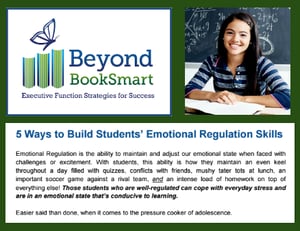Editor’s note: This week, we feature guest blogger Ari Fox, LCSW-R, of CopeWithSchoolNYC.com, where a version of this article was published. Please read more about Ari below.
"He's just a shy boy!" 
"She'll outgrow her clinginess."
When is a child showing typical degrees of shyness and when does it become more concerning? It can be easy for parents to overlook social anxiety in their child because they think the child is just shy or reserved. Yet social anxiety is much more serious than shyness. And while they can look similar, it’s important to understand the signs and know what you can do to help your child interact confidently and build healthy relationships.
For the sake of clarity, there are some key differences between social anxiety and shyness. Thankfully, it’s fairly straightforward to identify the signs and symptoms of social anxiety.
Most importantly, you should know that social anxiety is more than just a fear of interacting with others. It can manifest as a crippling fear for your child when they think about being around people who might judge or criticize them.
What Are the Symptoms of Social Anxiety?
The most obvious symptom of this type of anxiety is an intense fear of different social situations. It could include anything from some type of performance in front of others, to a small social setting where your child will be expected to interact with people.
Some other common symptoms to look for include:
- Clinginess to people they know
- Physical symptoms like trembling or nausea
- Worrying about social events days (or weeks) ahead of time
- Disproportionate fear about an event
- Avoidance of social situations
One of the biggest ways to tell if your child is suffering from social anxiety is if it seems to consume them for a long period of time. Not wanting to go to a social event is one thing - but if they have anxiety or fear about it for several weeks, or months, it’s time to consider the fact that there may be a bigger problem. It may be helpful to reach out to a school counselor or mental health professional for an evaluation if you notice that your child is experiencing signs of social anxiety.
What Causes Social Anxiety in Children?
There are several potential causes of social anxiety. It can occur due to a traumatic experience, evolved feelings of shyness, or social setbacks throughout their childhood. It can also be a result of other mental health challenges, such as OCD. Additionally, there may be an inherited aspect of social anxiety. (See this resource from Mayo Clinic for more information about social anxiety.)
You might start to see noticeable symptoms of social anxiety in your child as early as 8 years old. For most kids, though, the signs really start to show up when they reach their teenage years.
How Can Parents Help a Child With Social Anxiety ?
Fortunately, parents can often help their children deal with their social fears. Once you’re able to give a name to the struggles they’re facing, you can both tackle the problem together. Many parents also find it useful to collaborate with a therapist to help them support their child.
Keep in mind that your child might not know why they feel so anxious in social situations. As their parent, you can help them understand, and give them tools they can use to manage those feelings.
What's the first thing you can do? Teach your child how to be calm in situations that make them feel anxious. Something as simple as deep breathing exercises can help. You can also use imagery through storytelling, meditation, or yoga to help your child to learn how to calm themselves. When they’re in a more relaxed state, it’s easier to get a handle on their worries and fears.
Most anxious feelings come from assuming the worst. Once your child is in a calm state, talk to them about how to change their negative thoughts and assumptions into positive ones. Help your child recognize their negative thoughts by encouraging them to say the thought out loud. Together, you can work on turning it into a more positive thought.
A Process to Work Through Social Worries
For example, your child may say "I am worried that no one will talk to me at my friend's birthday party." First of all, validate your child's concern to let them know you are listening to their perspective: "It can be upsetting to feel left out, especially when everyone else seems to be having fun." Next, brainstorm some possible scenarios. "Let's make a list of who might be there. Who do you feel most comfortable with? Who do you share interests with?" Then help your child think of ways to join in or initiate conversations with peers who will be at the party. "You said that Tyler loves basketball - what could you ask that would interest him and get him talking with you?" Finally, help your child to transform that worry into a positive statement: "I know how to talk to other kids. When I show interest in them, they will respond and talk to me."
Over time, parents can use a process like this to help their children to work through their feelings regarding uncertainty or possible embarrassment. Helping your child to identify the things that make them anxious will make it easier to work through as a team. You can practice scenarios at home, or slowly introduce them to situations that make them fearful while letting them know they’re safe.
Overcoming Social Anxiety
One of the key signs of social anxiety is avoidance. While avoidance might be the easier path, it’s not really helping your child face and overcome their fears. If social fears aren’t addressed when your child is young, they can carry them into adulthood. From there, they can manifest into even more social and mental health struggles. While confronting social anxiety early on is never simple or easy, the cycle of avoidance that sufferers of social anxiety experience can lead to fewer opportunities for a fulfilling life in the long run, if left unaddressed.
Thankfully, it’s possible to work through social fears. Once you’ve identified your child’s struggle, talk with them about it at home, with your child’s teachers and coaches, and consider consulting with a therapist for further support. Joining a social skills group can be a great way to gain confidence in a safe and nurturing setting. From there, maintain the commitment to working toward addressing your child’s fears. Offering resources that aid successful coping and confidence as they proceed through school can make all the difference in keeping anxiety in check.
Photo above by Annie Spratt on Unsplash
 Ari Fox is the Director of CopeWithSchoolNYC. He is a licensed clinical social worker specializing in child, adolescent and young adult psychotherapy. He earned a bachelor’s in psychology from Brandeis University and a master’s in social work from City University of New York – Hunter College School of Social Work. Ari received postgraduate training at the William Alanson White Institute, where he earned a certificate in child and adolescent psychotherapy.
Ari Fox is the Director of CopeWithSchoolNYC. He is a licensed clinical social worker specializing in child, adolescent and young adult psychotherapy. He earned a bachelor’s in psychology from Brandeis University and a master’s in social work from City University of New York – Hunter College School of Social Work. Ari received postgraduate training at the William Alanson White Institute, where he earned a certificate in child and adolescent psychotherapy.
 Download our guide that features 5 strategies our coaches use to help students keep their emotions on an even keel.
Download our guide that features 5 strategies our coaches use to help students keep their emotions on an even keel.

